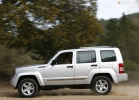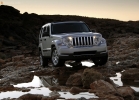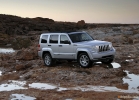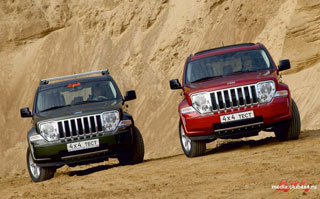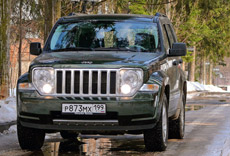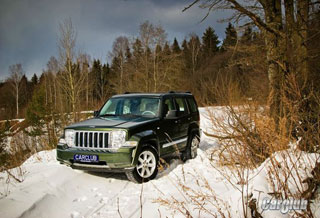Jeep Cherokee (Liberty) test drive since 2007 SUV
Battle of SUVs: Large races in a career near Minsk
The idea to collect several SUVs in a career belonged to our colleagues from the automobile television program of the autopanorama that was on the STV channel. Recently, our tests have become joint, and you could notice this through parallel cars flashing on the pages of AH and in the autopanorama. When they began to look for dealers who have something, it turned out that at the moment the assortment is very scarce - the cars located in show rooms have already been sold, while others were still ordered. As a result, the tests were four of the most striking representatives of an off -road tribe - two Mitsubishi - Pajero and Pajero Sport, and two classic Americans - Chevrolet Tahoe and already becoming a parable Jeep Grand Cherokee. That still the company gathered ...All SUVs, regardless of the manufacturer, brands, capacities and prices, are divided into three main subclasses: professional SUVs, universal cars and SUVs - almost cars, only in a jeep form and with all -wheel drive. Each of these classes has its own advantages and disadvantages, advantages - each of them is created for operation in various conditions, therefore, in design, two almost identical externally jeeps can vary very much. In one of the past numbers, AH already had such a significant test, during which we tried to clearly demonstrate the advantages and features of the behavior of two diverse cars-then these were Mercedes-Benz G-class and ML class.
This time, the company gathered even more motley, although formally all the SUVs that participated in the test belong to the so -called universal models, which can be approximately successfully operated on off -road and on flat asphalt roads. But we found the general features and accurate adherence to the canons of style in only two models, and the other two are generally not clear by what principle were designed.
And that is why we will begin, perhaps, by listing the structural features of the whole four. Mitsubishi Pajero Sport - it is the most inexpensive and simple in this company and does not have any electronic excesses or too complicated transmission. Which, by the way, gives out its origin - the car was designed on the basis of the L200 utilitarian pickup, which became the basis and donor of units and nodes. Its design is more than traditional: a spar frame, a dependent rear suspension and an independent front, connected to a rigid all -wheel drive (without a center differential), a number of reduced gears. By the way, in the American market, this model, called Montero there, has a spring suspension, but for the Europeans more comfortable, the Japanese proposed a more comfortable spring. Naturally, like all rogues, Pajero Sport has a fairly mediocre manageability and an average level of comfort. If you drive along the broken roads constantly, sometimes you go out of nature, when you really need all-wheel drive and lowering gears, then it makes sense to maintain such a car. In the city, where small dimensions, agility and economy are more valued, there is absolutely nothing to do on such a mastodont: its appetite will not allow you to drive away from gas stations, and parking it somewhere in the center at rush hour is also a very dubious pleasure. However, this fully applies to other participants in the test: Pajero Sport among them is the most modest in size, and there will be even more problems in the city with the rest.
The Pajero Sport and one of the Americans is structurally identical - the enormous and chic Chevrolet Tahoe. The same spar frame, a dependent suspension from the back and independent front, connected front axle, etc. The difference is only in the size, engine power and the design of the all -wheel drive transmission: Tahoe has an interdose differential, which allows the car to operate in all -wheel drive mode for a long time. But the other two participants in the dough were surprised: it seems to be exactly the same rinks as the two previous cars, but if we talk about design features ... Let's start with the fact that Mitsubishi Pajero III does not have a frame - an obligatory attribute of a real SUV. More precisely, it is, but not the same as the two previous models, instead of traditional sponge ladder, this car is integrated into the body. It turns out to be saving by mass, additional space in the cabin and a lower center of gravity - as a result, controllability improves. Suspensions of all wheels are independent, which is also nonsense for the SUV, although everything else, like adults, is connected all -wheel drive, demultiplier, and differential locks. Pajero III has the most perfect transmission of the whole four, which allows you to constantly ride in both the rear and all -wheel drive mode, and even block the center differential to overcome the most complex sections. The American Jeep Grand Cherokee cannot boast of the same high technological level as that of the Japanese, but nevertheless, by design it is also a team of the national team - symbiosis of traditional and innovative solutions. To begin with, the Grand of Rama does not have a traditional sense either - as in Pajero, it is integrated into the body. He has a constant all -wheel drive, there is a reducing gear and the distribution system of torque between the wheels, automatically transferring the torque to the wheel, having the best adhesion to the road. But pendants, really nonsense - dependent beams, both in front and behind. Actually, this is a very strange combination: the carrier body and dependent pendants, which are more than off-road, are not suitable. But these are the Americans, even in the most expensive cars they do not cost anything to use an archaic, but cheaper solution in production. Which, by the way, can be observed in many American models, including Cadillac. Naturally, such a combination of things inconsistent has not led to anything good: with independent pendants, at least in front, Grand Cherokee would behave much better, and comfort would be an order of magnitude higher.
***
It just so happened that everyone came to the flocks at different times: the guys from the autopanorama went to the Americans to the quarry, and we had to wrap in the Codes for two Mitsubishi. And upon arrival, the picture that we found reminded the film Apocalypse today: wiped along and across the road, clouds of soil on roadside Christmas trees and traces, everywhere traces of skidding wheels. It seems that one of the Americans has already managed to demonstrate their youthful daring: only a powerful car can ride so recklessly. So it is: heaps of sand on chrome sections of Chevrolet Tahoe give out a hero who was able to plow half a career. Still, with an eight-cylinder engine and on the rear-wheel drive! In general, Chevrolet Tahoe is the most colorful and impressive. Without a doubt, a real American - gigantic dimensions, an abundance of chromium - do not be a dock in cars to guess where this machine is produced.
And oddly enough, it is made at a fairly high technical level: to change the transmission modes, switching from the rear to all -wheel drive, you can buttons on the panel, and not levers, as in the Japanese, and the Autotrack system allows you to ride at least the whole winter using all -wheel drive. The system itself determines the slipping of the rear wheels, and if the transmission works in all -wheel drive mode, automatically connects the front axis, increasing stability and cross -country ability. Then, when the machine moves back in normal mode, the front axle turns off until the next case of slipping. This method is convenient in that it allows you to save fuel, because it works, in fact, only the rear -wheel drive, and the front is connected only at certain points. In his career, everything, as having conspired, went to Tahoe only in the rear -wheel drive mode: there are just a lot of impressions! Dima Novitsky, Espert of Avtopanorama, called the button to turn on the rear -wheel drive a source of pleasure - when it presses it, hefty taha turns into an evil and stringent supercar. You press the long-flowing gas pedal to the floor, and the powerful 5.3-liter motor instantly breaks the rear wheels into the slip, leaving a long train behind the machine. However, the rear wheels break into the slip for literally any reason: I squeezed a little on the pedal, and back it is heard how the sand flying in all directions is rustling in the wheeled arches. Probably, on the tested car there were tires with a too universal tread pattern - neither on the ground nor on the asphalt they could provide this hefty SUV with the proper degree of adhesion to the road. But thanks to them, you can ride a Chevrolet Tahoe very spectacular, as if on a rally Subaru Impreza: with slipping, passing turns by fan, etc. The start from the place reminds of the rally. Desperately slipping, Tahoe wags the stern, forcing the driver to adjust the skip, preventing the car from turning across the road.
If everything is in order with the nervous system and driving experience, you can try to get this monster to leave the place in a spectacular drift: a boxing, the car easily rides almost sideways. You can also go through the turns, even on the asphalt. To discharge gas and a sharp, one might even say, the provocative movement of the Tahu steering wheel meets the deep skid of the rear axle. If at this moment you have the courage to abruptly add gas, enough speed to quickly and clearly work out to the wheel and experience to enter the turn sideways, in the eyes of a very pale and frightened girlfriend, you will forever remain crazy Max. Or, now forever, a good guy in the memory of all the acquaintances, if you don’t have enough of the above factors: not everyone is given to slide on a two-ton whale, and you should not forget about a high center of gravity. It is still not worth it to flirt with this SUV in the rear -wheel drive mode: this is not a sportkup, and such tricks are clearly a burden for him. Again, the braking distance from behind the tires can greatly surprise you, as well as the driver that stopped in front of you - you always need to keep a one and a half distance in stock.
But traveling to Chevrolet Tahoe is calm - the highest pleasure. The car is very soft, quiet, comfortable, spacious, and I quite understand those Americans who buy such travel cars - it can only be a large luxury van. However, a high landing makes itself felt: on the road waves, the car sways from side to side, forcing passengers to nod their heads synchronously. But this is not so noticeable, especially since in the chic leather chairs TAHOE you perceive any vibrations as lulling. Even if you rush off -road, the car sways softly, without transmitting any sounds to the salon. Personally, I don’t really like it: having played, you can skip a serious obstacle. Moreover, the overview of the forward is very specific: due to a huge hood, a five-meter blind zone is formed in front of the machine, so it is necessary to evaluate the complexity of the obstacle from afar, when it is really very difficult to consider it.
Another American is not much better - Jeep Gran Cherokee. He also has a tendency to drift the rear axle, although not as pronounced as Tahoe. It seems, due to the constant all-wheel drive: it helps a lot of the car to stabilize, so frank skid is obtained only at a very high speed. The presence of hard dependent suspensions in front and behind also does not add advantages to the grand: on the asphalt, it reacts very much to all the bumps, swinging the body and vibrating very much. On off -road, dependent pendants feel much better, thanks to them you can ride the way you want. Where Tahoe is practicing an obstacle, risking struck by protecting the pallet on the obstacle, the Grand Chrikee simply takes off - if you add gas, then you can hear how sometimes the wheels break away from the ground. The dependent suspension in any case remains the lowest element, so all the blows are on it. It would be logical to see as an elastic element of the springs, as in real, professional SUVs, but then the Jeep Grand Cherokee would have turned out to be too condo - a spring is more rigid in any case. True, recalling the load -bearing body, even an enhanced frame integrated into it, I don’t want to ride on the off -road anymore - you never know what.
And what about the Japanese? The Pajero family, as always, is on top. Let them not create the impressions of the unbearable, like Tahoe, but in terms of strength of strength they surpass it. Almost parquet in design Pajero III is actually one of the most advanced off -road models, which also received good running qualities as a bonus, almost like the asphalt model. Like Tahoe, this Japanese rogue can ride both in the back and on all -wheel drive, without time limits. There is a hard all -wheel drive mode, with a blocked interdessual differential, if necessary, you can turn on a reduced gear and activate the locking of the rear inter -axle differential. As a result, it turns out that Mitsubishi Pajero III is an absolute champion among the entire quartet. With such an arsenal, you can compete with Toyota Land Cruiser or even Range Rover.
The experience accumulated in the course of participation in rally marathons allows Mitsubishi to make unique cars. And let him go not as softly as Americans, in fact, Mitsubishi Pajero seems to be the most acceptable option for buying. It is not such a glutton, although the appetite of the 3.5-liter engine is also not weak: it is much more compact in size and, most importantly, it is much more high-quality-still a Japanese assembly. The only but can be attributed to his behavior on the road: for a car with independent pendants, Pajero is still a little harsh. It will steer well, although it is best to extremize on this car in all-wheel drive mode: the hellish mixture from a very short base of the three-door version and power of a 3.5-liter motor makes it very sharp. I slightly went too far with gas, and a train rises from behind - the car is slipping. Moreover, it does not work to play sliding, as on Tahoe: despite the sharp steering wheel and relatively rigid pendants with reptile stability stabilizers, it is much more difficult to control the car in skidding. Although, if there is a mechanic there, the car would probably become more obedient: the machine is too spreading to add gas, and on a dirt road it is very difficult to control the moment of breakdown of the rear wheels. Give a little gas - the car rides slowly, give a little more - and it is already slipping. It is much easier with all -wheel drive: no slippers, no drifts, no sharpness. You just go to yourself, not paying attention to the quality of the coating. Even on clean ice on such a machine you can move calmly.
But on Mitsubishi Pajero Sport, despite the presence of all -wheel drive, it will not work to move so reliably from September to March: the transmission design does not allow to ride with the connected front bridge for a long time. When the front axle is connected, a strict connection is formed between the bridges with the distribution of torque in a ratio of 50/50. That is, the wheels of the front and rear axle, obtaining the same portions of power, should take the same distance. But this happens only if the car moves straight - the wheels spin at the same speed and pass the same distance. But if the car turns or, worse - turns around, the inconsistency begins - the front wheels pass more distance than the rear. But the torque is distributed equally, which means that the kilometer should be exactly the same. What to do? Drive straight! A joke, of course, but with a tough front drive connected to do so, it is best to do. On the turn, the rear wheels that have passed a smaller distance and have an excess of torque because of this, are forced to slip, forcing the transmission to strain. Moreover, they will do this in any case, regardless of whether liquid dirt under the wheels, snow or dry asphalt. As you yourself understand, regular forced skirmishes of the rear wheels do not add a resource either tires, transmission, or the engine that is forced to force the rear wheels to slip. And that is why in each SUV with a rigidly connected front bridge in a prominent place there is an instruction that reminds of the need to include all -wheel drive only in extreme cases and only in slippery areas. In his career, Mitsubishi Pajero Sport felt very confident: if necessary, the rear wheels were easily slipped relative to the front ones, and this did not create any tension for the transmission. In terms of comfort, Sport was inferior to all participants in the dough, especially imposing Americans: his pendants are hard, the rolls on the bends are large, and the vertical, stool landing does not contribute to active piloting. Although it is worth noting that Pajero Sport among classmates is considered one of the most sports: its landing, against the background of competitors, is considered still normal, even a passenger. In general, despite some excessive modesty, Mitsubishi Pajero Sport also seems to be a very interesting option for buying: it is the cheapest, the most unpretentious, while the salon is much more spacious than the Jeep Grand Cherokee.
Here, in general, and all that I wanted to tell about four crooks tested in a career in flocks. You can see a video version of this test in the autopanorama and see firsthand how different these cars ride.
Text: Pavel Kozlovsky and Sergey Mitskevich

